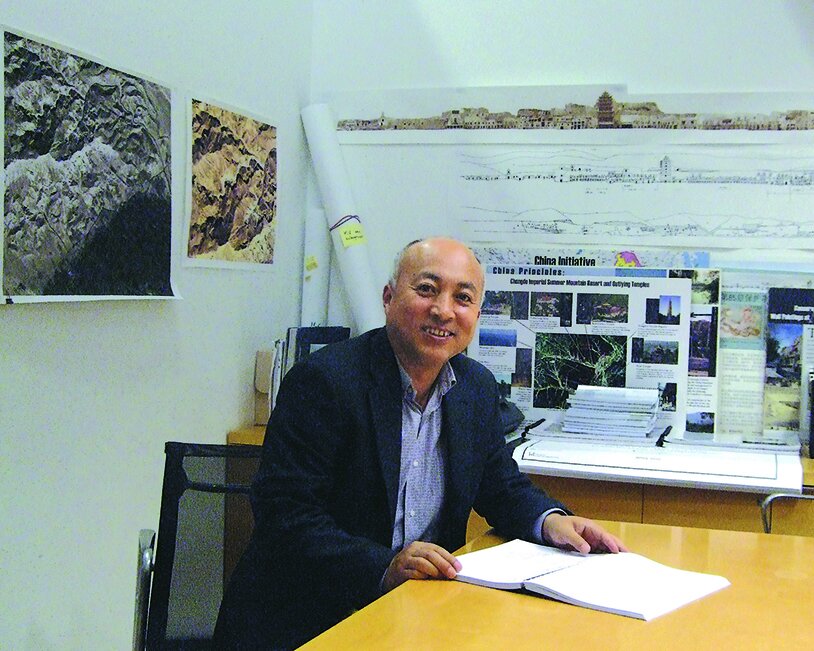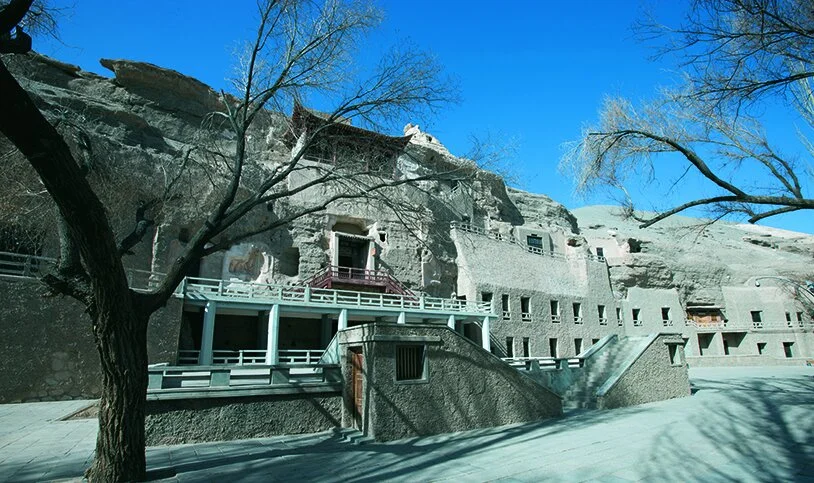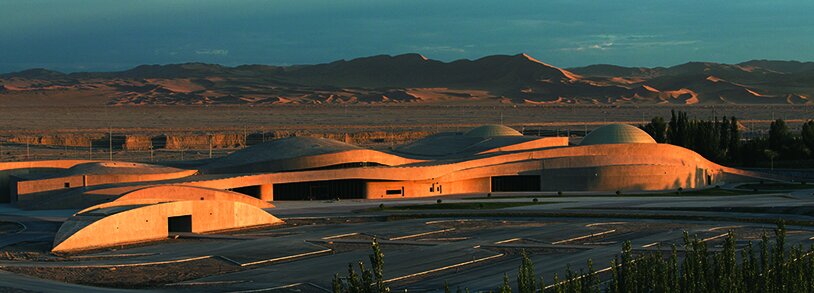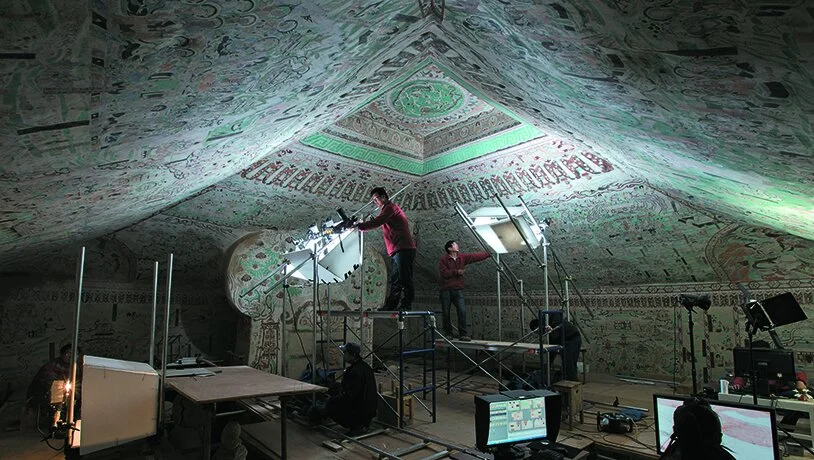In Conversation with Wang Xudong, Director of the Dunhuang Academy
The Mogao caves at Dunhuang comprise 492 cave temples, replete with murals, statuary and manuscripts accumulated over the course of 1,000 years, from approximately the 4th to the 14th century. As such, the site is considered one of the most significant troves of Buddhist art anywhere in the world. It was awarded the status of World Heritage Site by UNESCO in 1987.
For more than 25 years, the Getty Conservation Institute and the Dunhuang Academy have maintained a collaborative partnership intended to protect, research and promote this treasury of art and cultural heritage. The exhibition ‘Cave Temples of Dunhuang: Buddhist Art on China’s Silk Road’, on view at the Getty Center from 7 May to 4 September 2016, celebrates this partnership.
To introduce this special issue dedicated to Dunhuang, Orientations talked to Dunhuang Academy director Wang Xudong to find out more about his thoughts on the significance of the site, what he is planning for the future, and how the academy’s work at Dunhuang can be applied to aid in the conservation of other ancient sites.
Wang Xudong on a visit to the Getty
Orientations Director Wang, you’ve been deputy director of the Dunhuang Academy since 2005, and were recently appointed director. Could you tell us a bit about your background and training, and how you came to be involved with Dunhuang?
Wang Xudong I graduated with a bachelor’s degree in engineering geology from Lanzhou University in 1990, and a master’s in environmental science in 1998. I received my doctorate on the conservation of cultural relics in 2002, also from Lanzhou. Before joining the Dunhuang Academy, I had worked in water conservancy survey and design for just under a year. At that time, the academy was recruiting geologists to join its international conservation team, in cooperation with the Getty Conservation Institute. I was recommended by Lanzhou University, and subsequently joined the project. I joined the academy in 1991, so this year marks my 25th year with the organization.
O Can you talk about your vision for the future of the academy?
WX I hope to build on the foundations laid by our predecessors—Chang Shuhong, Duan Wenjie and Fan Jinshi—in terms of cave conservation, expanding the academy’s domestic and international collaborative efforts, and further developing conservation and research of the site.
With regard to cave conservation, the plan is to transition from emergency conservation to preventive conservation, to construct risk monitoring and warning systems, and to speed up progress on the ‘Digital Dunhuang’ project. The priority is to authentically and comprehensively protect the caves, murals and statues.
Through the Digital Dunhuang repository we want to open up our digital resources to international academic communities. The Dunhuang Academy should serve as an international focus for Dunhuang studies, and we want to attract more domestic and foreign experts—especially young scholars—to work with scholars from the academy on Dunhuang and the caves. We will also explore opportunities for setting up exchange programmes with colleges and museums overseas. We have to make efforts both to satisfy visitors and to promote Dunhuang cultural heritage in colleges, classrooms, communities and online.
Photograph from the 1908 Pelliot expedition, view of the Mogao cliff face before reinforcement
O In 2016 the art of the Mogao caves will be the subject of a major exhibition at the Getty Center, as highlighted by the articles in this issue, with three full-sized cave replicas hand-painted by artists from the academy. Why are exhibitions like this so important for the future of Dunhuang?
WX Exhibitions like this are valuable because they give people the opportunity to view the magnificence of the Mogao caves and the work of our specialists and artists without having to travel all the way to Dunhuang. In another respect, our work with international organizations has enabled us to integrate new study methods and ideas into our own practice, and has led to great advances in our conservation, study and management capabilities.
One of the collective outcomes of our projects is that a community of talented professionals has settled at Dunhuang. The academy now comprises some 1,000 personnel, of whom 232 are humanities and social science researchers, as well as research and conservation specialists. Overseas experts regularly come to Dunhuang to carry out collaborative research: five specialists from the Tokyo Research Institute for Cultural Properties, or Tobunken, visit once or twice a year, focusing on mural preservation and art-historical research. The Getty Conservation Institute also visits twice a year to undertake studies on such aspects as visitor capacity, mural protection and environmental monitoring. We also jointly run a graduate mural research course with the UK’s Courtauld Institute of Art.
O This year also marks the tenth anniversary of the Dunhuang Academy’s collaboration with the International Dunhuang Project, or IDP. How is this initiative helping to further scholarship and understanding of Dunhuang and the Silk Road both in China and abroad?
WX IDP, founded in 1994, works across countries and organizations, and Dunhuang Academy joined IDP as a partner in 2006. Over the past twenty years, IDP has been working on digitization of the dispersed heritage from the Mogao caves, along with the development of the Digital Dunhuang project. The IDP has done a great deal to improve our understanding of Dunhuang and has internationalized the study of the Silk Road.
Present-day view of the Mogao caves after reinforcement and preservation work
O The Digital Dunhuang project is a major undertaking to digitize the 492 caves. How does Digital Dunhuang relate to the IDP?
WX The digitization project began in the early 1990s, with research into the technology. In 2000, with the support of the Andrew W. Mellon Foundation, the Dunhuang Academy and Northwestern University joined the project. Since 2007, the involvement of Zhejiang University, Wuhan University, the Institute of Computing Technology at the Chinese Academy of Science, and Microsoft Research Asia has contributed to the development of digital collection, storage and reproduction technology for the murals and the sculptures. Digital Dunhuang at present focuses on aspects such as the digitization of the murals, 3D reconstructions of sculptures and cave spaces, permanent storage, and digital exhibition of the data. The IDP, on the other hand, concentrates primarily on the digitization of relics from the Library Cave that are held in collections all over the world. Our goal is to establish a global sharing platform for digital resources, integrating the cave paintings, sculptures and architecture with relics from the Library Cave and other related materials, to serve as a digital repository.
O Do you have plans to extend the academy’s reach to other sites in China? What sort of interaction do you have with such sites from the point of view of sharing expertise on things like mapping and digitization?
WX The government has been supporting international collaboration at the Dunhuang Academy for many years. We’ve made all sorts of achievements in cave conservation management that we would like to share with colleagues all over the world and, of course, at other cultural heritage sites in China. Indeed, technology and ideas that we developed at Dunhuang have already been applied in the conservation of murals at sites in Tibet, Xinjiang, Ningxia, Hebei, Shanxi, Shandong, Inner Mongolia and Gansu, achieving good results.
We have cooperated with conservation projects at the Kizil and Yungang caves [in Xinjiang and Shanxi provinces, respectively], and we are planning to exchange expertise with the authorities in charge of the Longmen caves in Henan province. In the digitization sphere we have developed a whole set of specialized procedures and methods that we are willing to share with other institutions.
The Visitor Center at Dunhuang
O How much support does the academy receive from private and public entities in China?
WX Various collaborative projects are being supported by the government. Chinese NGOs focused on Dunhuang include the China Dunhuang Grottoes Conservation Research Foundation, the Dunhuang Foundation in the US, and The Friends of Dunhuang in Hong Kong.
O What is the greatest threat to the murals and sculptures, and what is being done to limit further damage?
WX The splendour of the Mogao caves comes from the interplay between the cave construction and the extraordinary murals and sculptures. The caves were chiselled into the loose sand-conglomerate; pigments for the murals were made from mixtures of local soil, straw, cotton or flax, and mineral pigments. Apart from some of the larger, stone-cored sculptures, most figures were constructed by applying clay to a wood frame. The caves, murals and sculptures are, therefore, all very fragile. Natural phenomena—earthquakes, rain and sandstorms, for example—continue to form a threat. Human activity has long been a menace, and increased tourism to Dunhuang has posed bigger conservational challenges than ever. To counteract these threats, in addition to increased conservation efforts we are currently setting up a risk monitoring system, to propel the transition from emergency conservation to preventative conservation.
Digitization work in progress
(Photograph: Sun Zhijun)
O How many of the caves are now open to the public?
WX Sixty caves are open to the general public each year. Of these, thirty are regularly open; ten are opened on special request; while twenty more are open during the high season. In the high season, from 1 May to 31 October, each tour group may visit eight caves that are opened on a rotational basis. In the low season, from 1 November to 30 April, each tour group may visit the regularly open caves, along with twelve that are opened on a seasonal basis. Visitors may also apply to visit special caves.
O Some caves will never be open to the public because of the age and condition of the murals, but some—such as Caves 45 and 220—are now viewable in virtual immersive formats. Can you talk about the importance of the visualization of images of the murals and sculptures? What have been the most difficult challenges in the process?
WX In mitigating the potential harm caused by visits from the public, the ability to present the caves and their art digitally has been a huge boon, and it’s a tremendously valuable resource. But the high costs of developing and maintaining the presentation facilities, and the generally vague comprehension of intellectual property rights in China, have meant that it cannot be improved substantively in the near future.
O Does this mean that there are no new digitization projects under way, or that there are limits to how many caves can be presented digitally?
WX One of the goals of digitization is the permanent preservation of the information provided by the caves, so we will continue with that programme. At the same time, we would like to gradually share the arts of the Dunhuang caves with the world. In 2016 we expect to share online the results of high-precision digitization of murals from thirty of the caves; and users will need to pay a fee before viewing. Scholars and the general public will be able to make use of these precious ancient art resources, while at the same time visits will generate revenue that will contribute to the development of the Digital Dunhuang project.
View of Cave 158, showing the Buddha in parinirvana
(Photograph: Wang Jian)
Cave view with environmental monitoring equipment shown in the foreground
(Photograph: Sun Zhijun)
O How do you think the display of the virtual caves and the closing off of some important caves for conservation will impact the visitor’s experience? What sort of responses have you had from visitors so far, both to the caves themselves and to the virtual caves?
WX The virtual caves enable viewers to experience different aspects of the site, but of course people won’t get the opportunity to get close to the actual relics. The approach requires balance; a combination of virtual display and conventional site visits can protect the relics and satisfy visitors at the same time. The solution must be one that protects this precious heritage for future generations.
So before visitors enter the actual caves, they are able to view documentaries at the theatres in our Visitor Center, which gives them a deeper understanding of the site, and allows them to experience immersive full ‘dome displays’ for seven of the caves. This new model, combining virtual displays with an actual physical tour, creates a great impression among visitors, and is highly beneficial with regard to the conservation of the site.
O What, for you personally, are the most remarkable parts of the site, and which cave or artwork has left the greatest impression on you since you joined the academy?
WX I find myself fascinated by the harmony of the Mogao caves and their natural surroundings. I hope the site can be protected in its entirety. My personal favourite is cave 158 [constructed under the period of Tibetan rule], which is a reflection of the theme of the historical Buddha, Shakyamuni in parinirvana.
A dome cinema at the Dunhuang Visitor Center showing a 360-degree view of a cave interior
(Photograph: Sun Zhijun)
Orientations would like to express our gratitude to Susan Whitfield of IDP (idp.bl.uk) for her advice and support in conducting this interview.
This article first featured in our May 2016 print issue. To read more, purchase the full issue here.
To read more of our online content, return to our Home page.








